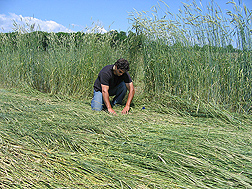This page has been archived and is being provided for reference purposes only. The page is no longer being updated, and therefore, links on the page may be invalid.
| Read the magazine story to find out more. |
|
|
|
|
Finding the Right Time for Rolling Rye
By Dennis O'BrienNovember 16, 2010
U.S. Department of Agriculture (USDA) scientists are helping growers adopt an environmentally friendly practice that is catching on nationwide: "rolling" their rye when they use it as a cover crop.
Cereal rye is increasingly being used as a cover crop because it prevents erosion, helps the soil retain nutrients, and reduces the need to till the soil, according to Steven Mirsky, an ecologist in the Agricultural Research Service (ARS) Sustainable Agricultural Systems Laboratory in Beltsville, Md. ARS is USDA's principal intramural scientific research agency, and this research supports the USDA priorities of responding to climate change and promoting international food security.
When used as cover, rye is planted in the fall, killed in the spring, and left to decompose in the same fields where soybeans and other cash crops are later planted. But instead of mowing their rye, many farmers will flatten it out by attaching a rolling, paddlewheel-like cylinder with metal slats to a tractor and barreling over the rye, tamping and crimping it into a mat.
Rolling rye with a roller-crimper uses less energy than mowing, is faster and only needs to be done once a season. Unlike mowing, it also leaves rye residue intact in the field, forming a thick mat that can provide better weed suppression, according to Mirsky.
Mirsky planted two common types of rye, "Aroostook" and "Wheeler," in test plots in Pennsylvania at six 10-day intervals in two successive falls. He used a 1.5-ton steel roller-crimper, constructed by colleagues at Pennsylvania State University, to flatten the rye at 10-day intervals each spring. He then visually rated the rye's regrowth on a scale of zero to 100, six weeks after each plot was flattened.
The results, published in Agronomy Journal, showed that the best time to roll the rye is when it reaches 50 to 75 percent of its flowering state, because that is when rolling consistently kills the rye. The researchers also are working toward a web-based tool that growers around the country will be able to use for guidance, possibly by typing in ZIP Codes or other information that identifies their locations.
Read more about this research in the November/December 2010 issue of Agricultural Research magazine.

